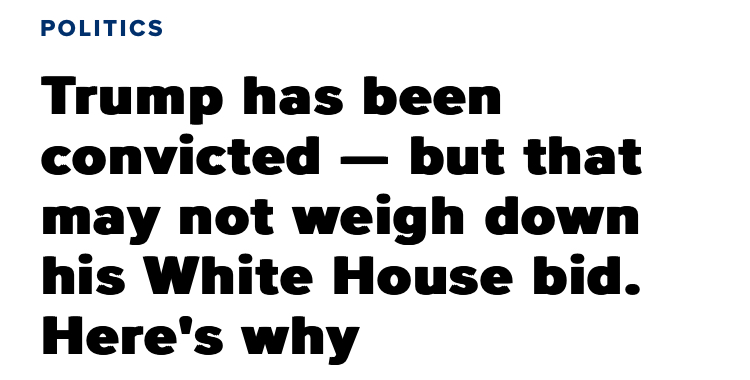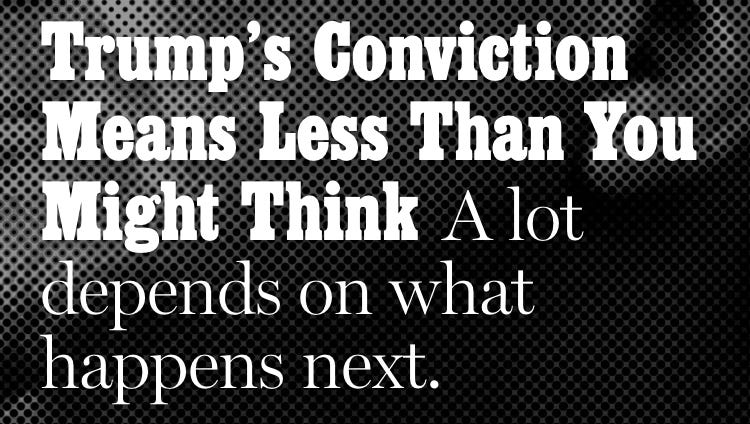Good News, Bad News: May 31, 2024
With 157 days left until Election Day we need political coverage that uplifts and defends democracy.
Every week until the election, we’ll compare our pro-democracy election coverage guidelines with ongoing election coverage to highlight which newsrooms are standing up for democracy and which are sleepwalking us towards a dictatorship. We hope this inspires you to make more informed choices about where you get your news and strengthens your resolve to join us in advocating for the pro-democracy media Americans need. And now…
THE GOOD NEWS
‘Democracy Day’ to Award Stipends For Pro-Democracy Coverage
Democracy Day is a collaborative journalism effort initiated by Montclair State University to defend American democracy through journalism. Its mission is to “provide clear explanations of what’s happening (and what could happen), give practical information on what members of the public can do, and uncover new revelations related to anti-democratic efforts.”
Democracy Day’s website further explains: “We have chosen Sept. 15 as a day when print, radio, TV, and digital media on the national and local level will come together to report on the threat we’re facing. This will include original reporting, aggregations of existing reporting, and op-eds.”
In a recent Medium post, project coordinator Beatrice Forman announced the program is now offering stipends to newsrooms to support the production of Democracy Day content.
Our goal is simple: To fund great work from newsrooms about local and national threats to democracy and the stakes of the 2024 election that wouldn’t be able to happen otherwise.
Learn more here. The deadline for applications is June 14th.
Wow! Threats to Democracy, Election Workers Highlighted by Meet The Press
Chuck Todd was so accommodating to Congressional spreaders of the Big Lie towards the end of his tenure at Meet The Press that I think I’m traumatized. Every time I see his replacement, Kristin Welker, do journalism in defense of democracy, it doesn’t feel real. But, it’s real and, honestly, it’s spectacular.
Welker opened this weekend’s program with these words:
“This Sunday, the threat to democracy.”
Swoon! The program featured a round table of four swing state Secretaries of State. Welker asked Arizona SoS, Adrian Fontes, about how he’d been personally affected by threats to his family:
There were some let downs. Welker allowed Georgia SoS, Brad Raffensberger, to mention multiple times that his state now required voter ID, without providing any context that it’s an unnecessary vote-suppressing strategy born of the Big Lie. But overall, this entire episode was the mainstream version of our guidelines asking newsrooms to expose candidates who foment political violence and uplift election workers and the election process. A transcript of the episode can be found here. Great work!
The New Republic Explains ‘What American Fascism Would Look Like’
Trump continues to ratchet up his fascist rhetoric. It was reported this week that he promised a room full of donors that he would “crush pro-Palestinian protests [and] deport demonstrators.” The need for plain-speaking from our nation’s journalists about the threat he poses has never been greater. So it was heartening to see The New Republic devote its May 16th coverage to a series of articles outlining the danger.
As editor Michael Tomasky explained:
“Today, we at The New Republic think we can spend this election year in one of two ways. We can spend it debating whether Trump meets the nine or 17 points that define fascism. Or we can spend it saying, ‘He’s damn close enough, and we’d better fight.’”
Congratulations to The New Republic for making threats to democracy clear.
Honorable Mentions (other pro-democracy coverage of note this week):
The Nevadan: ‘Early voting for Nevada’s primary election starts May 25. Here’s what you need to know’ - “At The Nevadan / El Nevadense, our mission is to provide valuable and accurate information for readers to make informed decisions and participate in democracy.”
Applicable MAD Guideline: Celebrate and uplift election workers, voters, and the election process.
New York Times graphics team provides amazing graphical representation of Trump’s history sowing election doubt - The Times graphics team provides overlaying graphs that contextualize for readers how much more election lying he is doing than ever before. Why is this kind of work not a regular feature? How is the Times producing this type of coverage while simultaneously de-prioritizing articles about Trump calling for the Constitution’s “termination” by placing them on page A13? After pondering these mysteries, go check it out. It’s quite impactful.
Applicable MAD Guidelines: Call out lies and bad behavior in every piece of reporting.
THE BAD NEWS
Newsrooms Rush to Communicate That a Candidate’s Felony Conviction Doesn’t Matter
Yesterday, Donald Trump became the first ever U.S. president to be convicted of a felony. He is also the first ever major party candidate to run for the White House as a felon. He had extra-marital sex with a porn star, paid her money to deceive voters, and falsified business records and cheated on his taxes in order to hide the payment. A jury of his peers heard the evidence and found him guilty on all 34 counts.
While many front page headlines prominently carried the news of Trump’s guilt, our most influential newsrooms are already communicating to the public that they should not consider this a very big deal.
Your first instinct may be to say, “All those things are true. Voters will decide how they feel about it in November. It may not make that big a difference.”
You may recall that in last week’s column I wrote, “Newsrooms can make a big deal out of, and paint as a beyond the pale scandal, anything they want. That they have not made those choices for Trump suggests a willful desire not to.” The above headlines are even more glaring, consequential examples of America’s major newsrooms choosing to normalize Trump and downplay his disqualifying behavior. And that’s terrifying.
Let’s explore a little more about newsroom choices and mainstream media’s clear, consistent pattern of treating Trump better than everyone else. Media Matters reported this week that “Major news outlets gave much less coverage to Trump’s ‘vermin’ attack than they did Clinton’s ‘deplorables’ remark.” As you may remember, in 2016 Clinton was lambasted for referring to half of Trump’s supporters as deplorables—“racist, sexist, homophobic, xenophobic, Islamaphobic”—while also stressing that the other half “feel that the government has let them down, the economy has let them down, nobody cares about them, nobody worries about what happens to their lives and their futures, and they’re just desperate for change…Those are people we have to understand and empathize with as well.” By comparison, in a speech last November Trump made a fascist threat to “root out the communist, Marxist, fascist and the radical left thugs that live like vermin within the confines of our country.”
Media Matters found that in the first week following each remark, the top 5 U.S. newspapers by circulation “ran a total of 29 news articles mentioning Clinton’s ‘deplorables’ remark — 13 of which ran on the front page…By contrast, the papers combined for just 1 print news article that mentioned Trump’s ‘vermin’ comment, which ran in the interior of The Washington Post.” Trump was given a pass by major newsrooms about threats he made, while Clinton was framed as problematic for condemning hate. I repeat, news executives can paint as a beyond the pale scandal anything they want. It is a choice to do so or not.
Now, go back to that first instinct you may have had seeing all those whitewashing Trump conviction headlines above. Would any other politician receive such framing? Consider that none of the articles had to even be written at all. Consider that each of those major outlets could have chosen to use the occasion of Trump’s historic conviction to instead call for him to drop out of the race, as they have been doing for Biden based on his trailing Trump by a point or two, or his being just three and a half years older.
Media narratives matter deeply because humans suffer from availability bias, the tendency to rely on whatever information comes readily to mind when evaluating situations. By presenting Trump’s lawlessness within frames that downplay consequences, newsrooms render him as somehow unburdened by the rule of law that just convicted him. As they’ve been doing since 2015, media executives are providing Americans with information that Trump’s behavior is excusable and doesn’t matter, at a much higher rate and with far more prominence, than information that Trump’s disqualifying behavior is…actually disqualifying.

We need our newsrooms to change their ways. They must immediately begin to apply the same moral standard to all candidates. They should adhere to our pro-democracy election coverage guidelines.
Extra Credit: Pro-Democracy Quote Of The Week
(Are our major newsrooms PR firms for the anti-democracy forces at our doorstep?)
“Public relations specialists make flower arrangements of the facts, placing them so the wilted and less attractive petals are hidden by sturdy blossoms.”
- Alan Harrington
Democracy’s Survival Requires That Newsrooms Reset to Focus on What’s at Stake
You can be part of the solution. We’re attaching our pro-democracy guidelines to an open letter for you to sign on to. This letter will be distributed to the leadership of all major news organizations. The guidelines serve as a model of what pro-democracy election coverage can—and should—look like. Signing our letter ensures that your frustrations with media’s failure to stand up for American democracy will be heard loud and clear.
Help others advocate for positive change. Share the letter and guidelines with friends, civic organizations, and everyone who cares about the future of America. Ask them to sign on. Demanding better media is an action we must all take.
Tired of paying for corporate media that doesn’t stand up for democracy? Redirect those funds to quality local journalism. Use our Local Journalism Directory to find an outlet and subscribe.
















Things are bleak if Welker's weak sauce is cause for praise.